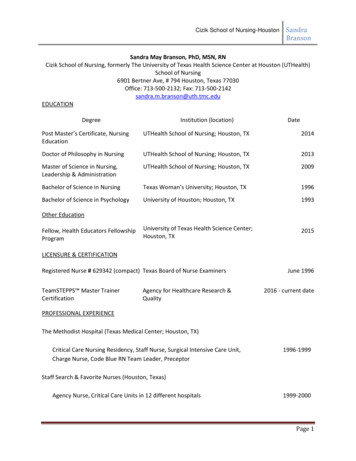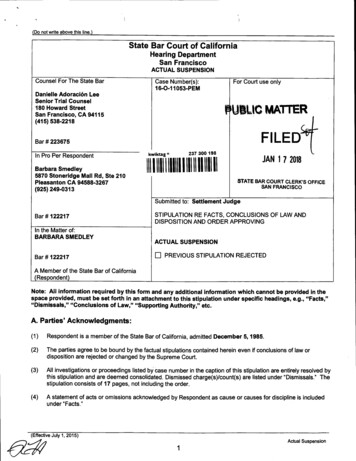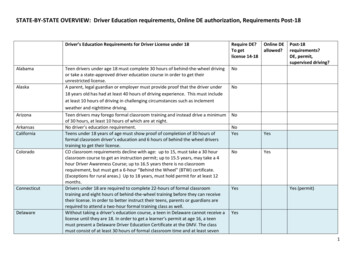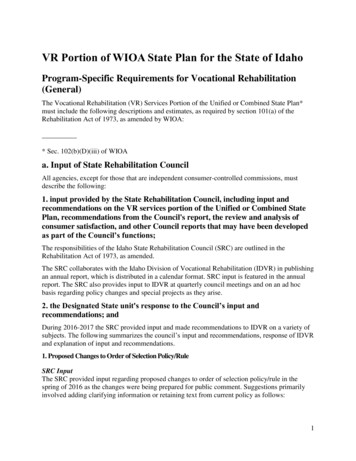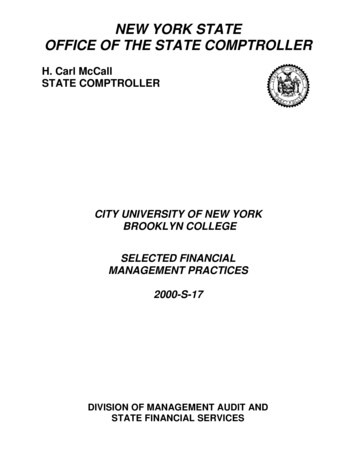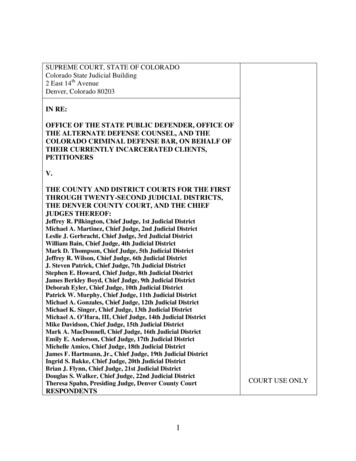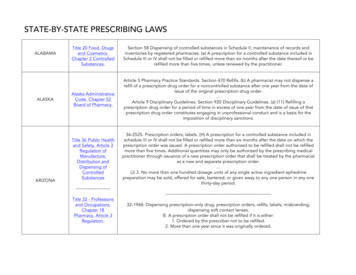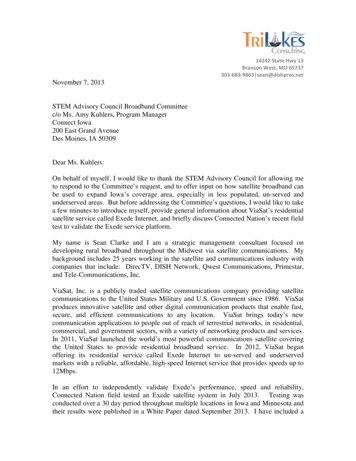
Transcription
14242 State Hwy 13Branson West, MO 65737303-683-9863 sean@dishpros.netNovember 7, 2013STEM Advisory Council Broadband Committeec/o Ms. Amy Kuhlers, Program ManagerConnect Iowa200 East Grand AvenueDes Moines, IA 50309Dear Ms. Kuhlers:On behalf of myself, I would like to thank the STEM Advisory Council for allowing meto respond to the Committee’s request, and to offer input on how satellite broadband canbe used to expand Iowa’s coverage area, especially in less populated, un-served andunderserved areas. But before addressing the Committee’s questions, I would like to takea few minutes to introduce myself, provide general information about ViaSat’s residentialsatellite service called Exede Internet, and briefly discuss Connected Nation’s recent fieldtest to validate the Exede service platform.My name is Sean Clarke and I am a strategic management consultant focused ondeveloping rural broadband throughout the Midwest via satellite communications. Mybackground includes 25 years working in the satellite and communications industry withcompanies that include: DirecTV, DISH Network, Qwest Communications, Primestar,and Tele-Communications, Inc.ViaSat, Inc. is a publicly traded satellite communications company providing satellitecommunications to the United States Military and U.S. Government since 1986. ViaSatproduces innovative satellite and other digital communication products that enable fast,secure, and efficient communications to any location. ViaSat brings today’s newcommunication applications to people out of reach of terrestrial networks, in residential,commercial, and government sectors, with a variety of networking products and services.In 2011, ViaSat launched the world’s most powerful communications satellite coveringthe United States to provide residential broadband service. In 2012, ViaSat beganoffering its residential service called Exede Internet to un-served and underservedmarkets with a reliable, affordable, high-speed Internet service that provides speeds up to12Mbps.In an effort to independently validate Exede’s performance, speed and reliability,Connected Nation field tested an Exede satellite system in July 2013. Testing wasconducted over a 30 day period throughout multiple locations in Iowa and Minnesota andtheir results were published in a White Paper dated September 2013. I have included a
copy of the report for the Committee members and the viewing public at the end of thisdocument.I.What barriers or other issues can you identify that may impede the increase ofbroadband access, adoption and use across the state?Build out cost and scale has been a barrier for all broadband providers, especially as itrelates to providing service in both un-served and underserved areas. As is evidenced inthe responses from other participants to the Committee’s questions, providing a robust,competitive broadband service requires a tremendous amount of money, time, resources,and population density with the hope that customers will eventually subscribe to theservice long enough to pay back the build out cost and generate a return on theinvestment for the private enterprise.Additionally, offering a broadband service that is both reliable and affordable have beenthe two areas that rank at the top of most customer satisfaction surveys. Offering aterrestrial broadband service in un-served and underserved areas requires cabling andelectronics that are principally constructed aerially to reduce build out cost for the limitedhome density service area. By not placing this equipment underground, and mitigatingthe weathering effects and nature’s elements, reliability is impacted, and maintenancecosts can easily escalate when compared to urban/suburban, underground constructedbroadband networks.The barriers mentioned above speak to precisely why satellite communicationstechnology has been developed and deployed to provide a reliable, cost-effective, andaffordable solution to the un-served and underserved areas of Iowa. Instead of requiringmultiple permits, requesting legislatures for subsidies, and lengthy build outs for theseless populated areas, satellite technology can provide an elegant solution immediately vs.months, or even years from now for the rural population of Iowa.II.If you had to choose one primary barrier, what would that be?Availability/Immediacy. Looking back at history, cable television began in the early 70’sthrough terrestrial platforms in urban/suburban areas with little, if any interest towardsserving the rural population but if we take a step back, in the early 90’s, along comes anascent product: Satellite Television, and 20 years later, there are now over 30 millionviewers watching television through a satellite dish. In addition, we now have satelliteradio with over 30 million listeners, and every new automobile has GPS technologyembedded it, which is delivered via a satellite network.The same chronology can be drawn for broadband. The industry has seen terrestrialproviders begin with 56k dial-up; enhance it to 1.5 Mbps, then offer today’s broadbandservices in the urban/suburban markets, while once again neglecting the un-served and
underserved customer. One company’s neglect is another’s opportunity these unserved and underserved areas are the primary markets for satellite, and customers in thesemarkets have enjoyed the many benefits of satellite products for years. Satellitebroadband is offered today at speeds up to 12Mbps, and is just one more example of howneglected customers experience the same technology found in Iowa’s majorurban/suburban markets.As so often is the case, history appears to be repeating itself. Satellite Broadband is thetechnology that provides the solution for rural America. The early days of satellitedelivered Internet were no different than television; and as the technology has evolvedinto today’s offering, satellite broadband is a legitimate, viable service that needs to beconsidered by the members of the Committee when looking for solutions for the unserved and underserved markets throughout Iowa.The cable operators, the phone companies, and the fixed wireless providers appear tohave the same approach with offering solutions to un-served and underserved areas itcan be done, but not without investment support from either the local/state/federal entity,or the taxpayer. ViaSat is not asking for assistance because the investment has alreadybeen made and the risk accepted. ViaSat constructed the satellite, launched it, assembleda national network of service providers, developed a voice service, and establishedpartnerships with DirecTV and DISH Network to offer bundled services to the un-servedand underserved customer.In addition, ViaSat recently announced construction for a second, next generationsatellite that will offer 2x the capacity of its current award-winning satellite. The newsatellite will cover North America, Central America, the Caribbean, and sea and air lanesbetween North America and Europe.Today, ViaSat is offering its award-winning service with organizations such as theAmerican Red Cross for disaster recovery efforts; JetBlue Airlines is in the process oflaunching in-flight Internet service to its passengers using ViaSat’s service, and UnitedAirlines will be offering a similar service in the near future utilizing ViaSat.The availability/immediacy may be a barrier for the terrestrial providers, but satellitebroadband provides an immediate solution for those neglected in un-served andunderserved areas in Iowa and offering the service requires zero taxpayer assistance.ViaSat is currently adding many customers every day in Iowa, and will continue to do sothrough its state-wide sales and distribution network.III.What recommendations do you have to overcome these barriers?A collective approach with input from stakeholders, private enterprise, and state & localgovernment officials will provide the best solution to eliminating these barriers.
Soliciting a cross-section of service providers and stakeholders should not only providevarious options, but also establish a priority for identifying areas that can be addressed inthe short-term with today’s solutions, but also position the state long-term options aswell.Speaking on behalf of myself and others, the satellite industry wanted to take thisopportunity to create awareness for the Committee, and to foster thoughtful, educateddiscussions why satellite broadband should be considered a legitimate solution forresidents of Iowa that have chosen to live in un-served and underserved areas.Empowering residents in un-served and underserved areas with broadband opens doorsand creates opportunities that can be nurtured into tangible economic development.Whether it is offering a rural student access to a distance learning application, providing asmall business with Internet access to manage its operations, or eliminating the need for arural patient to drive long distance for a doctor’s visit, these examples can all beaccomplished today through satellite technology and providing this access will notrequire months of build out or taxpayer assistance; only a two hour window to install theservice and empowerment begins with the student, the business, and the patient.IV.What are your expectations for future access needs?Consideration. Policy makers need to understand that satellite broadband exists todayand can be leveraged when implementing decisions and crafting Broadband Policy. Anydiscussion regarding future access should include satellite broadband as a viabletechnology, and how it can be used to augment the state’s terrestrial network. Given therapid improvements in broadband technology, and the challenges with providing it to allpopulation segments, satellite technology offers an efficient, effective solution with norequirement for taxpayer funds; it can be deployed immediately, and is now a leadingtechnology.V.Other comments?Once again, I would like to thank the Committee for this opportunity, and hope that thethis response provides both an awareness of today’s satellite technology, but moreimportantly offers an education into a viable, immediate solution for Iowa’s lesspopulated areas with reliable and affordable broadband Internet.As mentioned earlier, I have enclosed a copy of Connected Nation’s White Paper thatdiscusses its independent testing results for ViaSat’s Exede platform, and provides furthersupport as to the service level and its 12Mbps performance.
In addition, the Federal Communications Commission conducted testing this year tomeasure broadband performance and below is a direct quote from the FCC’s resultsregarding ViaSat’s Exede residential service:“During peak periods, 90 percent of (Exede) consumers received 140 percent or betterof the advertised speed of 12 Mbps.” -FCC 2013 Measuring Broadband Americareport.Regards,Sean ClarkePrincipalTri Lakes Consulting
CONNECTED NATION SATELLITE BROADBAND FIELD TESTING REPORTSEPTEMBER 2013With equipment spinning thousands of miles above the surface of the earth and covering vastphysical land masses, satellite broadband validations have been a bit of a challenge forConnected Nation’s Engineering and Technical Services (ETS) team until now. This white paperdiscusses some of the challenges of satellite as a broadband platform, a new process developedby the ETS team to validate satellite broadband providers in the field, and results from avalidation methodology derived from leveraging CN’s broadband inquiry database.Residential Satellite Broadband TodaySatellite direct‐to‐home broadband services have experienced numerous improvements intechnology and capabilities in recent months. Residential satellite broadband can now delivermulti‐megabit speeds and vastly improved performance compared to earlier versions at anaffordable price. Satellite broadband is available to virtually every consumer location withinthe continental United States, as long as a clear view of the southern sky is available.While WiFi networks utilize certain frequencies to operate at very short distances, satellitebroadband uses spectrum licensed by the Federal Communications Commission to transmit atmuch higher frequencies, able to reach 22,500 miles from the earth’s surface. The view of thecontinental United States is excellent from that distance, and the customer equipment back onEarth is extremely efficient in communicating in a two‐way broadband Internet mode with thesatellite systems deployed in geo‐synchronous orbit in space.When satellite delivered broadcast television services are in use, one is joining in on a broadcastsent to thousands of consumers in a one‐way, receive‐only mode. With any Internetbroadband connection, however, each connection is typically delivered individually to theperson making the request, thus requiring two‐way communication, and sufficient bandwidthto accommodate all of the simultaneous requests. Even though the radio signals are travelingat the speed of light, there is a slight time delay from the moment a person makes a request athome to the time a response is received back from the satellite. This delay is called “latency”and is typically caused by signal processing that occurs within all routers, switches, servers, andtransmission equipment.Latency is present in all broadband services to varying degrees, based upon several factors, butis usually very short – typically 50 milliseconds with terrestrial broadband services such as DSLand cable modem. As a comparison, a human blinks at a speed of about 300‐400 milliseconds(ms), so a person would normally not notice terrestrial broadband latency. In satellitebroadband systems, however, latency is longer due to the great distance in sending the signals1
to and from the earth – in addition to the normal terrestrial latency. A satellite broadbandsystem located 22,500 miles away – nearly the entire distance around Earth’s equator – has atypical latency of at least 700 ms, or more than ten times the latency found with terrestrialbroadband systems.In addition to the challenge of high latency, additional problems have historically plaguedsatellite broadband technology from a marketing perspective. Such problems includeexpensive equipment costs and service plans, complex installations, and slow broadbandservice in comparison to other land‐based cable, DSL, fixed wireless, and fiber broadbandservices. This report steers away from the economics and marketing of the service and focusesinstead on the validation of the delivery system and its achieving broadband speeds.How is Satellite Broadband Deployed?Connected Nation recognizes five satellite providers offering residential broadband service inthe nine states and one U.S. territory in which CN currently collects and submits broadbanddatasets. Although each provider determines its own satellite configuration, this paper willfocus on one satellite broadband provider, ViaSat, who operates the Exede satellite deliverysystem. ViaSat also owns the WildBlue satellite broadband system.WildBlue service was an early entrant in satellite broadband and was sold across the country toaccommodate the demand for rural broadband where other traditional broadband serviceproviders did not, or could not, provide service. As the WildBlue customer base increased, andas Internet applications and bandwidth needs also increased to support a multitude of new“apps,” the system became overloaded – just as land‐based systems also became overloaded.Early adopters who had purchased their satellite systems with significant individual investmentbecame frustrated with slow and unreliable services, especially as additional new satellitecustomers came onto the system and compounded the problem.To resolve the congestion and overload problem created by serving the entire continentalUnited States with a small number of Internet broadband satellite transponders, ViaSat createdthe Exede delivery system. The deployment of this system required a highly technical andextremely aggressive investment plan based on spot beams covering small geographic areas onEarth – typically 200‐300 miles across. Spot beams re‐use frequencies in consecutive areasstacked together like a honeycomb. This deployment structure essentially multiplies theavailable capacity over and over with each additional spot beam deployed. The end result isthat the satellite broadband service bandwidth and capacity are greatly improved. ViaSat nowclaims that the Exede system has enough newly installed spot beam capacity to accommodatean additional 1 million residential users.Exede’s spot beams shadow, rather than replace, WildBlue satellite broadband signals. ViaSat’sstrategy for the rollout of the Exede spot beams was to first overlay coverage of earlier satellitebroadband deployments where the highest density of satellite broadband subscribers alreadyexisted. By doing so, the company can minimize overloading the older systems as new2
customers come on board. As a result, ViaSat operates WildBlue and Exede servicessimultaneously with separate speeds and technical platforms. For example, the WildBlueservice offers download speeds as high as 5 Mbps, whereas, Exede advertises a 12 Mbpsservice.ViaSat’s WildBlue Footprint and Exede Spot BeamsWhite areas have no ViaSat satellite coverage.Exede’s Advertised Broadband Speed3
Obtaining residential satellite broadband service is relatively easy and affordable, althoughearly adopters are often chagrined at a second equipment investment required to make use ofimproved services. For Exede’s satellite service, each system is installed and activated by alocal, professionally trained dealer within the Exede network. Satellite television installers maynot be qualified to install satellite broadband due to the more rigorous requirements related tothe two‐way connection needed for broadband Internet.Validating Satellite BroadbandConnected Nation’s ETS team has two main objectives in validating a provider’s broadbandservice: 1) confirm the provider’s presence in the target testing area, and 2) confirm that theprovider’s Internet service meets or exceeds the required minimum broadband speed. Toconfirm a provider’s presence, a CN technician would visit, inspect, and document (often withpictures) provider office locations, broadband equipment in the field, billboards, and other localadvertising, and detected WiFi networks. For mobile and fixed wireless networks, a techniciancan often perform signal tests for known frequencies licensed to and/or used only by thatprovider. If an Internet connection is found and accessed in the field, the detected provider’sservice could also be tested using a speed‐test utility.Over the past three years, attempts to use any of these techniques for satellite validationproved futile as the basic tools for validating other platforms do not exist for satellite. Forexample, residential satellite equipment for broadband is difficult to distinguish from satellitevideo gear as viewed from the street. Further, a satellite installer can serve several counties,and may not have a retail presence. As a result, confirming the presence of a specific satelliteprovider in any targeted community has been challenging. In trying to confirm broadbandspeeds, historically slow speeds and high latency on the satellite services have also preventedthis level of validation.The CN ETS team recently devised an approach to confirm both presence and speed bydeepening the desktop research in advance of field validation, accessing controlled use ofsatellite testing equipment, and leveraging CN’s rich database of broadband inquiries. UsingExede as a participating test subject and model for satellite broadband validation, an ETStechnical engineer fine‐tuned the process in Iowa and Minnesota as described below.The first objective was to confirm that Exede service was available throughout a targetedservice area. In addition to using the Exede coverage map above, the engineer used Exede’swebsite to look at each i
companies that include: DirecTV, DISH Network, Qwest Communications, Primestar, and Tele-Communications, Inc. ViaSat, Inc. is a publicly traded satellite communications company providing satellite communications to the Unit
